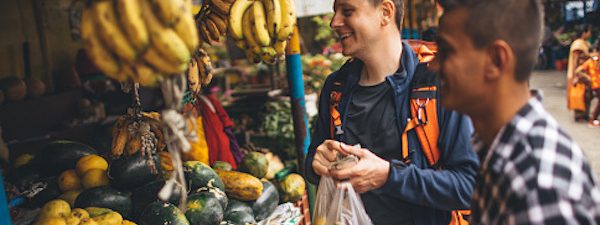Many or all of the products featured here are from our partners who compensate us. This influences which products we write about and where and how the product appears on a page. However, this does not influence our evaluations. Our opinions are our own. Here is a list of our partners and here's how we make money.
After transportation and hotel costs, food and drink expenses can often be among the biggest budget-busters of any vacation.
Whether you’re trying to stretch your per diem on a business trip or get the most value per dollar on your family excursion, here are some ideas for saving on meals and beverages.
Before your trip
Seek accommodations with a kitchen(ette)
The ability to refrigerate and cook food — or even just microwave it — can be a major way to save money. If you can score a hotel, motel or Airbnb with a few kitchen appliances, then a quick trip to the local grocery or convenience store can limit your spending on dining out.
In fact, you can turn grocery shopping into its own mini-adventure once you arrive, according to Paula Pant, founder of AffordAnything.com. She says that going to a foreign grocery store can be a fun way to explore a new culture. Wandering the aisles and trying to translate labels in different languages is all part of the experience — and Pant advises that you go with the flow.
“You might think you’re getting butter, but it turns out to be yogurt," Pant says. " ... The trick when grocery shopping is to not be attached to any kind of outcome."
If you're road-tripping, consider smoothies
Small snacks are portable and can save you money, but they may not be particularly filling or healthy.
“If possible, bring a blender with you, especially if you’re on the road,” Pant says. “You can bring that blender into your hotel room and go to the grocery and get some leafy greens (like kale), fruit, dairy and protein powder and blend it up. It’s a great way to save money on food and get enough greens.”
Take (OR GET) a credit card that earns dining rewards
Some credit cards, especially travel cards, offer bonus points for dining out. Although such rewards will defray only a small percentage of a big restaurant bill, they can add up quickly over the course of a trip. If you're traveling internationally, make sure your card isn't charging you a foreign transaction fee, which could eat up any rewards you earn.
Bring a refillable water bottle
Purchasing one-time-use plastic water bottles every time you get thirsty? Not very cost-efficient. Skip the expense (and the frequent trips to the store) by bringing a sturdy, reusable bottle or travel mug.
Do some research on Yelp OR Groupon
These sites might not always yield the best results for places to eat and drink, but occasionally you’ll find a legitimately good deal. At least check in advance and cross-reference the restaurants with customer reviews. Consider signing up for Yelp Cash Back to get even more rewards for your dining. (Those rewards can be "stacked" with any points that your credit card earns.)
Consider an all-inclusive resort
By bundling your food, drink and accommodations into one lump sum, you can often pay much less than you would by buying everything separately.
During your trip
Limit dining out to one meal a day
Enjoying local cuisine is one of the best parts about traveling to a new place, but it can make a huge impact on your wallet if you do it multiple times a day. Consider narrowing down your dining out. Pick one meal per day — breakfast, lunch or dinner — that you're going to splurge on. Or rotate that meal each day so you get to try even more new food.
Matt Kepnes, founder of NomadicMatt.com, says lunch can be the ideal meal.
“Many restaurants, especially in Europe, offer lunch specials, where items on the dinner menu are offered at a huge discount,” he says by email. “You can get an amazing afternoon meal for a fraction of the cost you’d pay for the same meal in the evening. I usually tend to eat my ‘nice’ meal during lunch, because lunch specials and plates of the day are about 30 to 40% off what I might pay at dinner.”
Eat LOCAL food
Keep in mind that food and drink cost more when they have to be shipped long distances.
“Try not to try to eat the same types of food that you eat when you’re at home,” Pant says. “If you’re in Indonesia, for example, cheese or wine will be expensive. Eat what the locals eat.”
Be aware that touristy areas might not offer the best versions of local food and drink, and that the more popular an area is, the more expensive it might be to eat there. Get some restaurant recommendations from the locals and go where they go. You’ll likely get a more authentic experience.
Visit a food stand or food truck
These convenient grab-and-go options are one way to ensure you're eating locally. Food stands and trucks often infuse regional flavors into their fare, and they can be a filling and fulfilling alternative to pricey sit-down dining.
“In most places around the world (and especially in Asia), the streets are lined with little food stalls and areas where food is cooked openly on the street,” Kepnes says. “You grab a plate, sit down in a little plastic chair and enjoy a delicious meal. Street food is some of the best food in the world. Meals at street stalls — different from street vendors, who have a bit more permanent setup — cost less than a dollar most of the time and are a great way to really experience the local cuisine."
Avoid snacking
When possible, make sure your meals are big or at least filling; otherwise, you might be tempted everywhere you turn.
“A gelato here, a gelato there. A soda. A candy bar. An ice cream. A small pastry. It all adds up," Kepnes says. "Since the price is so small (‘It’s only a euro!’), we don’t think of snacking as having a big impact on our budget. But buying snacks a few times a day will slowly add up and throw your budget out of whack. It’s not something many travelers think of.”
Eat at buffets
Speaking of filling meals, a buffet could be just the ticket. Plus, it can be cost-effective.
“[Buffets] offer a great value for your money, even if they don’t always serve the best meals,” Kepnes said. “You can fill up on one meal for the entire day. They typically cost around $15 USD.”
Participate in local cultural events
Grab a local newspaper or alt-weekly and look for an event calendar. You’ll likely be able to find food and drink festivals that can provide great value for the cost of admission.
After your trip
Sure, go ahead and clean off your blender and travel mug. But more importantly, make sure you've actually earned those dining rewards on your credit card (it can take a billing cycle or two for them to show up), and then redeem them however they work best for you. You can use them to offset some of your travel expenses, or you can save them toward booking your next foodie-centric adventure.



